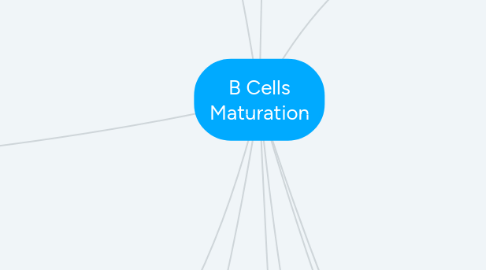
1. Antigen Recognition and Antigen-Induced B cell activation
1.1. B cell antigen receptor complex
1.1.1. B cell antigen receptor
1.1.2. Delivering activating signal to B cell
1.1.3. Ig mediated signals are transduced by IgA & IgB
1.2. IgA and IgB
1.2.1. Linked to each other by disulphide bond
1.2.2. Expressed in B cells noncovalently
1.2.3. Contain tyrosine-rich motifs in its cytoplasmic domain
1.3. Second signal for B cells
1.3.1. C3d
1.3.1.1. Act as the second signal for B cell activation
1.3.1.2. Ensure the B cell response to occur when via activation of complement during encounter with the microbes
1.3.1.3. Provides ampilification mechanism for humoral immune response
1.4. How the response of B cell is enhanced?
1.4.1. Activation of complement system
1.4.2. Activation of complement system
1.4.3. Production of C3b
1.4.4. Binding of C3b covalently or to microbe or antigen-antibody complex
1.4.5. Degradation of C3b into fragment called C3d which will be recognized by type 2 complement receptor
1.4.6. CD 19 is brought into proximity with BCR-associated kinase and the cytoplasmic tail rapidly become phosphorylated
1.4.7. Activation of several signalling pathway and respond of B cell is enhanced
2. B cell activation
2.1. Induced by antigen-mediated cross-linking of B Cell Receptor by diff types of antigen
2.1.1. Multivalent antigens
2.1.2. Protein antigens
2.2. Results after activation
2.2.1. Increased expression of receptors for several T cell derived cytokines
2.2.1.1. Signals produced by cytokine receptor interactions
2.2.1.1.1. Support B cell proliferation
2.2.1.1.2. Induce differentiation into plasma cells
2.2.2. Increased expression of MHC Class II
3. Antibody responses to t-cell independent antigens
3.1. Antibody is stimulated by non protein antigen such as polysaccharides and lipids.
3.2. Produced low affinity antibody consists mainly of IgM with limited isotype switching to some IgG subtypes and IgA
3.3. Antigens cannot be processed and presented by MHC
3.4. Cannot be recognized by CD+ Helper T cell
3.5. TI antigens are multivalent, composed of repeated identical antigenic epitopes
3.6. Multivalent antigen may induce maximal cross linking of BCR complex on specific B-cell, leading to activation without helper t cell
4. Germline Organisation of Ig genes
4.1. Ig and TCR genetic loci are fundamentally similar and are characterised by spatial segregation of multiple sequence
4.1.1. That encodes variable and constant domain of receptor protein of receptor protein
4.1.1.1. Constant domain
4.1.1.2. Variable domain
4.1.1.2.1. Light chain encodes V and J gene segments
4.1.1.2.2. Heavy chain encodes V ,D and J gene segments
5. Selecting one V gene, one J gene, and one D gene (when present) in each developing lymphocyte.
6. Rearrangement of DNA made of V, D and J gene segments.
7. Pre-B Cells
7.1. Found in hematopoietic tissues
7.1.1. Do not express membrane-bound antigen receptors
7.2. Synthesize cytoplasmic µ heavy chain
7.2.1. µ heavy chain associates with proteins = surrogate light chain
7.2.2. µ with surrogate light chain= pre-B cell receptors
7.3. Pre-B cell receptor
7.3.1. Stimulates proliferation and maturation of developing B cell
7.4. Allelic exclusion
7.4.1. Ensures every B cell express single receptor
7.4.2. Maintain clonal specificity
8. B Cell Activation and Antibody Production
8.1. B Cell Activation
8.1.1. Recognition of antigens by B lymphocytes
8.1.2. Ag binds to IgM and IgD receptors
8.1.3. Naïve B-cells activated
8.1.3.1. Proliferation
8.1.3.1.1. Clone expansion (antigen-specific cells)
8.1.3.2. Differentiation
8.1.3.2.1. Effector cells (Plasma cells and memory B cells)
8.2. Antibody Production
8.2.1. Involve in humoral mediated immunity
8.2.2. Mediated by secreted antibodies from plasma cells
8.2.3. Bind antigens (neutralize and eliminate microbes)
8.2.4. Different microbes requires effector mechanism mediated by distinct isotypes.
8.2.4.1. Ig G Ig D Ig E Ig A Ig M
8.2.4.2. Primary responses
8.2.4.2.1. Due to activation of antigen-unstimulated naive B cells
8.2.4.3. Secondary responses
8.2.4.3.1. Stimulation of expanded clones of memory B cells
9. Lymphocyte maturation
9.1. Process of converting mature lymphocytes that populate
9.1.1. Total APC= Lymphocyte Repertoire
9.1.2. Stage 1
9.1.2.1. Early maturation
9.1.2.1.1. Proliferation
9.1.2.1.2. Lineage commitment
9.1.2.1.3. Characterised by high mitotic activity
9.1.3. Stage 2
9.1.3.1. Expression of antigen receptor cells
9.1.3.1.1. Stem cells gives rise to B,T and NK cells
9.1.3.1.2. Expression of a diverse repertoire of antigen receptor genes is achieved by a process known as
9.1.3.1.3. If Pre B /T cells are in a single chain ,Ag receptor is not produced
9.1.4. Stage 3
9.1.4.1. Selection of mature repertoire
9.1.4.1.1. Immature lymphocytes express functional ag receptors
10. Somatic Recombination & Diversities
10.1. Somatic Recombination
10.1.1. Will form a single V(D)J gene that code for the variable region of an antigen receptor protein.
10.1.1.1. Diverse antigen receptor specificities is possible due to existence of several V,D and J segments.
10.2. Generation of B-Cell and T-Cell Diversities’ (repertoires) Mechanism
10.2.1. Junctional diversity
10.2.1.1. 1. N regions 2. P nucleotide addition
10.2.2. Combinatorial diversity
10.2.2.1. 1. Pairing of Ds and Js at H chain locus 2. Pairing of Vs at H-chain locus with rearranged DJ 3. Pairing of Vs with Js at light chain locus 4. Pairing of each rearranged H-chain with different L-chains

